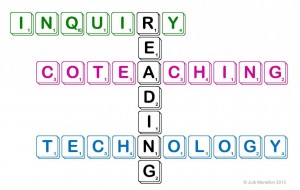For the past two decades, there has been a movement across the nation to “reform” education. The drumbeat of standards and accountability has dominated discussions about improving educational experiences for all children. The term reform itself has a value laden connotation. Think “reform” school… Reform from the top down-identify the problem and fix it. Instead, think about the term “transformation.” It has a more positive connotation-a movement from one status to another through innovation. Transformation comes from the inside out, in response to situations and experiences.
Meanwhile, as a culture, we are in the midst of a paradigm shift from an industrial to a technological age, and the transformation continues to redefine everything we have known. New norms are evolving in the business, political, cultural, and educational worlds. We are a work in progress, as usual-exciting times!
What does this have to do with collaboration?
Collaboration skills are the key for transformation to an educational system for personalized learning, not only for students, but for educators, administrators, and other community stakeholders. How do we learn and use those skills, and how do we teach our students to value and incorporate the contributions of all? How do we create environments and spaces that encourage creativity and collaboration for all learners? How does technology enhance the learning experience?
These big ideas were explored by the keynote speakers at the Dynamic Landscapes Conference at Champlain College in Burlington, Vermont on May 16-17, 2013. Jointly sponsored by Vita-Learn and the Vermont School Library Association, the annual conference showcases exemplary practices of statewide educators and invites national experts to address contemporary issues in education. Last week Ira David Socol, Pam Moran, and Steve Hargadorn spent several days visiting Vermont and sharing their expertise with attendees at the conference. Ira, an educational consultant and historian is currently working in the Albemarle County School District in Virginia where Pam is the superintendent. They are leading transformation through a collaborative model with educators in the local schools, and they shared their ideas and progress in encouraging innovation that focuses on personalized learning. Digital technology tools are integrated across the curriculum to enhance deep learning, collaboration, and engagement. Take a look at the videos for the Iridescent Classroom on Ira’s web site to get a glimpse of their work together. He also has a terrific overview of the history of education that contextualizes where we are today. Lots of resources there to explore, so take a look!
Steve Hargadorn, of Classroom 2.0, and Library 2.0, presented an overview of the process of how technology is changing our culture, and how that change will impact education in the future. Real educational transformation will come about with the evolution of the culture, so stay tuned. He shared many examples of how the cultural shift is happening due to the impact of social media and technology applications. Here is a link to his slides DynamicLandscapes2013Hargadon that demonstrate the shifting sands of the 21st Century. As I said before-exciting times ahead…
Once again, I was struck by aha moments, as I listened and learned. As educational leaders in our schools, teacher librarians are pivotal in the transformation process embedded in collaboration. As Steve Hargadorn said, “Be ready to unleash energy and potential through participation, creation, sharing, and engagement.”
Are you ready?
References:
Dynamic Landscapes Conference 2013. Web site. Retrieved from https://sites.google.com/a/vita-learn.org/dynamiclandscapes2013/home/th-keynote
Classroom 2.0. (2013). Web site. Retrieved from http://www.classroom20.com/
Hargadon, Steve. (2013). Education,Technology, Social Media, and You. Web log. Retrieved from http://www.stevehargadon.com/
Hargadon, Steve. (2013). Educational Network is the Learning Revolution: Future of Education. Dynamic Landscapes Keynote address, May 17, 2013. (PDF).
Library 2.0 (2013). Website. Retrieved from http://www.library20.com/
Moran, Pam. (2013). Superintendent’s Blog: Albemarle County Schools. Web log. Retrieved from http://superintendent.k12albemarle.org/
Socal, Ira David. (2013). Challenging the Systems. Web site. Retrieved from https://sites.google.com/site/iradavidsocol/
Microsoft Clipart: Crystal ball.





